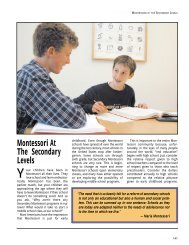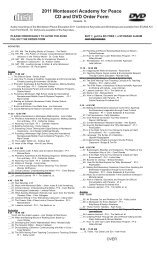Tim Seldin & Paul Epstein Ph.D. An Education for Life
Tim Seldin & Paul Epstein Ph.D. An Education for Life
Tim Seldin & Paul Epstein Ph.D. An Education for Life
You also want an ePaper? Increase the reach of your titles
YUMPU automatically turns print PDFs into web optimized ePapers that Google loves.
MONTESSORI PROGRAMS<br />
During a typical Montessori<br />
school day, children’s<br />
developmental<br />
needs and learning<br />
characteristics are met while they<br />
engage in their learning activities.<br />
Montessori noted through her<br />
research that children’s needs, interests,<br />
and abilities group into specific<br />
“planes of development.”<br />
A plane of development is a specific<br />
growth phase. Montessori taught<br />
teachers to design school classrooms<br />
to meet the needs and interests of<br />
children in each growth phase.<br />
Montessori also taught teachers to<br />
“follow the child” through careful<br />
observation. Through observation,<br />
teachers attend to each child’s learning<br />
approaches, strengths and weak-<br />
42<br />
Montessori Programs<br />
nesses, and interests and anxieties. The<br />
teacher next uses this in<strong>for</strong>mation to<br />
prepare learning environments and<br />
learning activities that facilitate the<br />
development of each child’s potential.<br />
The Planes of Development<br />
A plane of development is a specific<br />
phase of growth. Montessori educators<br />
typically talk about the first, second<br />
and third planes of development, corresponding<br />
to the ages birth to six; six<br />
to twelve; and twelve to eighteen. A<br />
fourth plane of development, from<br />
age eighteen to twenty-four years of age,<br />
is not of direct concern to this<br />
book but comprises the last stage<br />
of the journey from birth to adult<br />
maturity.<br />
Because the specific characteristics<br />
of each plane is different from<br />
the others, Montessori referred to a<br />
child’s development as a series of<br />
“rebirths,” and she believed that<br />
schools should not be divided by<br />
grades (kindergarten, first, second,<br />
and so on) but according to each<br />
plane. For this reason, Montessori<br />
schools consist of mixed-age<br />
groupings divided into early childhood,<br />
elementary, and secondary<br />
programs.<br />
Dr. Montessori’s study of children<br />
led her to conclude that child<br />
development is not linear. Children<br />
do not, in other words, develop in a<br />
(Below) <strong>An</strong> Early Childhood Montessori<br />
classroom.




